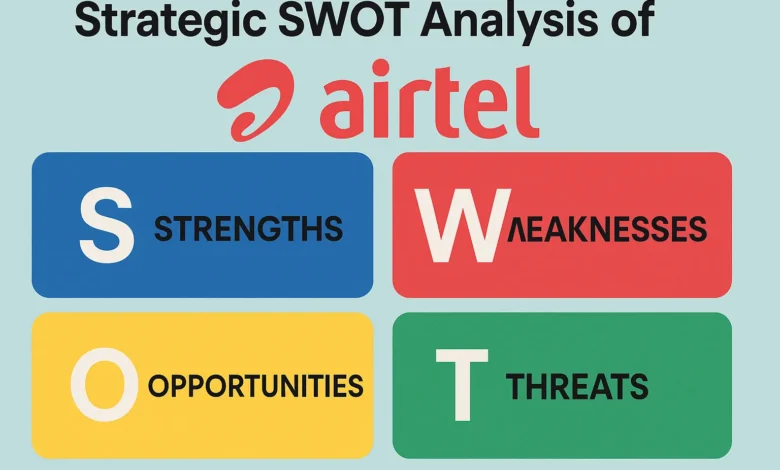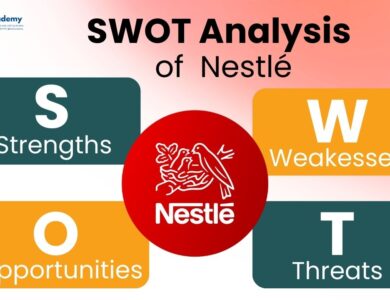Strategic SWOT Analysis of Airtel – Can It Maintain Its Telecom Dominance?
Explore Airtel's 2025 SWOT analysis, examining strengths, weaknesses, opportunities, and threats. Understand its strategy to sustain leadership in India's competitive telecom market

In India’s telecom industry, Airtel has long been a name synonymous with reliable services and innovative solutions. From providing affordable mobile connections to leading the charge in high-speed internet, Airtel has managed to hold onto its dominant market share in a space that’s both fiercely competitive and rapidly evolving.
However, as new players like Reliance Jio continue to challenge its supremacy with disruptive pricing and new technologies, one question remains: Can Airtel maintain its leadership position in the long term?
Founded in 1995 by Sunil Bharti Mittal, Airtel has transformed from a simple mobile telecom operator to a comprehensive digital services provider, expanding into areas like broadband, DTH, and even financial services with its Airtel Payments Bank.
Despite its stronghold, challenges like increasing competition, regulatory pressures, and rapidly changing consumer demands pose new risks.
This article will explore a strategic SWOT analysis of Airtel, diving deep into its Strengths, Weaknesses, Opportunities, and Threats to better understand how the company can adapt and continue to lead India’s telecom revolution.
We’ll also look at how Airtel plans to navigate the increasingly competitive landscape and capitalize on new technologies like 5G and digital transformation.
Also read: Complete SWOT Analysis of Jio – A Deep Dive into India’s Telecom Disruptor
Company Overview – About Airtel
Airtel was founded in 1995 by Sunil Bharti Mittal and quickly grew into one of India’s largest and most trusted telecom providers. Headquartered in New Delhi, Airtel is part of the Bharti Enterprises group and offers a wide range of services, including mobile services, broadband, digital TV, and enterprise solutions.
Today, it stands as a global telecom leader, with operations in 18 countries, spanning across Asia and Africa.
Airtel boasts a market share of over 30% in India’s mobile services sector, serving more than 400 million customers. It has diversified into digital services, offering everything from mobile payments and internet banking to OTT platforms and cloud solutions for businesses.
Not only does Airtel maintain a dominant position in India’s telecom market, but it’s also steadily expanding its footprint in emerging markets across Africa.
The company is known for its strong network infrastructure, which offers 4G and 5G services across major cities in India. It’s also the largest broadband provider in the country, and its DTH services make it a complete player in the home entertainment space.
With over ₹1,25,000 crore in annual revenue, Airtel is investing heavily in next-gen technologies like 5G, IoT, and artificial intelligence, positioning itself as a future-ready brand that is not only a telecom giant but also a key player in the digital ecosystem.
What is SWOT Analysis?
A SWOT analysis is a strategic planning tool that helps evaluate a company’s internal and external environments by identifying its Strengths, Weaknesses, Opportunities, and Threats.
It’s a useful framework for understanding the factors that contribute to a company’s success, as well as the challenges it might face moving forward.
- Strengths: Internal attributes and resources that give the company a competitive edge.
- Weaknesses: Internal factors that may hinder growth or efficiency.
- Opportunities: External conditions or trends the company can exploit for growth.
- Threats: External challenges or risks that could harm the company’s performance.
For a dynamic and highly competitive industry like telecom, a SWOT analysis provides valuable insights into how companies like Airtel navigate market shifts, innovate, and stay ahead of evolving customer demands.
It also sheds light on the potential risks that could impact Airtel’s market leadership, especially as competition intensifies in the digital age.
In this article, we will dive into Airtel’s SWOT analysis to understand how it leverages its strengths to overcome weaknesses, seize opportunities, and tackle threats in an increasingly competitive market.
Also read: Complete SWOT Analysis of Jio – A Deep Dive into India’s Telecom Disruptor
Airtel’s Strengths
Airtel’s continued leadership in the Indian telecom market can be attributed to its numerous strengths—ranging from its strong brand recognition and expansive network infrastructure to its diverse service offerings.
These strengths have enabled Airtel to not only maintain a dominant position but also to strategically evolve in the face of industry disruptions.
1. Market Leadership and Strong Brand Recognition
Airtel is one of India’s largest telecom service providers, commanding a significant share of the mobile market (over 30%). The Airtel brand is synonymous with reliable and high-quality services, earning strong customer loyalty across urban and rural markets.
Its consistent marketing efforts, community engagement, and innovative campaigns ensure it remains top of mind among consumers.
2. Extensive Network Infrastructure
Airtel has made significant investments in building a robust 4G network, and with its ongoing 5G rollouts, it continues to enhance its network coverage and service quality.
Its nationwide presence ensures that Airtel can offer reliable coverage even in remote areas, giving it a competitive edge over other players, especially in rural and underserved regions.
3. Diversified Service Offerings
Airtel is no longer just a mobile service provider. The company has successfully expanded into multiple sectors, including broadband, DTH (Direct-to-Home) services, and enterprise solutions.
Its Airtel Payments Bank also positions it as a player in the financial services market, offering services like mobile wallets, digital banking, and insurance. This diversification reduces Airtel’s dependency on any single revenue stream and opens up multiple avenues for growth.
4. Strong Technological Backbone and Innovation
Airtel has been a pioneer in digital services, introducing smartphone apps like Airtel Thanks to enhance customer engagement and loyalty.
The company is investing heavily in 5G technology, IoT (Internet of Things), and artificial intelligence to stay ahead in the digital transformation of the telecom industry.
Its cloud computing and enterprise solutions offerings make it a key player in the B2B sector, serving corporate clients with scalable digital solutions.
5. Customer-Centric Approach
Airtel’s customer loyalty programs, such as Airtel Thanks, offer exclusive rewards, discounts, and benefits for long-term users.
The company’s 24/7 customer support, personalized plans, and seamless online self-service options make it easy for customers to access and manage services. Its focus on customer satisfaction ensures higher retention rates and enhances its competitive edge in a price-sensitive market.
These strengths allow Airtel to maintain its position as one of the leading telecom providers in India and across the globe. However, in a fast-paced and competitive industry, it’s important to evaluate not only the strengths but also the weaknesses that may hinder Airtel’s growth.
Airtel’s Weaknesses
While Airtel enjoys a strong market position, it is not immune to internal challenges. Some weaknesses could hinder its ability to scale or maintain its leadership in an increasingly competitive telecom market.
1. High Debt Levels
Airtel’s high debt burden is a significant weakness. As of recent financial reports, the company has accumulated a debt of over ₹1.5 lakh crore. This large debt pile restricts its ability to reinvest in new technologies, network upgrades, and innovation.
Additionally, servicing this debt may limit its financial flexibility, especially in a highly capital-intensive industry like telecom.
2. Intense Price Competition
The entry of Reliance Jio into the telecom space has significantly disrupted the pricing structure of India’s telecom market. Jio’s aggressive pricing strategy forced Airtel to reduce its rates, which led to lower margins on its services.
While Airtel has focused on maintaining premium service offerings, its ability to compete with Jio’s low-cost data plans and free voice services remains a challenge, especially in price-sensitive markets.
3. Reliance on the Indian Market
Although Airtel has a presence in Africa and other international markets, the majority of its revenue comes from India. This overdependence on the Indian market makes Airtel vulnerable to domestic economic slowdowns, regulatory changes, or policy shifts that may affect its business operations.
Unlike some global players, Airtel’s limited diversification outside India exposes it to greater risks in terms of geopolitical and market fluctuations.
4. Slow Growth in Non-Telecom Segments
While Airtel has expanded into digital services, broadband, and enterprise solutions, these segments are still in the early stages of development compared to its mobile services.
Digital banking and payments services under Airtel Payments Bank have not yet scaled to the level of industry leaders like Paytm or PhonePe, which means Airtel’s diversification strategy is still at a relatively nascent stage.
5. Network Congestion and Service Disruptions
Despite substantial investments in network infrastructure, network congestion in high-density urban areas and service disruptions during peak hours continue to affect Airtel’s user experience.
This is especially problematic in an era where consumers expect seamless connectivity for everything from entertainment to work and education. Airtel’s ability to address these issues without compromising on cost will be a challenge.
These weaknesses underscore areas where Airtel needs to focus on cost optimization, debt reduction, and greater diversification to maintain its competitive edge. However, overcoming these challenges will unlock even more potential for growth.
Airtel’s Opportunities
Airtel is well-positioned to capitalize on several emerging trends in the telecom, digital, and financial services industries. By tapping into new market segments and embracing technological advancements, Airtel can continue to solidify its dominance in the competitive telecom sector. Let’s explore some key opportunities:
1. 5G Deployment and Future Technologies
The rollout of 5G technology offers Airtel a significant opportunity to enhance its service offerings. High-speed internet, low latency, and increased network capacity will not only boost customer satisfaction but also enable new services such as smart homes, IoT (Internet of Things), cloud computing, and autonomous vehicles. By being an early adopter of 5G, Airtel can differentiate itself as a leader in next-gen digital services.
2. Expanding Enterprise Solutions
Airtel has already ventured into cloud computing, enterprise connectivity, and data center services. With the growing demand for digital transformation among businesses, Airtel can strengthen its position in the B2B sector by offering more tailored solutions for SMEs, large enterprises, and government contracts.
Partnerships and acquisitions in this space could boost revenue from corporate clients, creating new streams of growth.
3. International Expansion in Emerging Markets
Airtel’s operations in Africa provide a strong foundation for further expansion. With the telecom industry booming across sub-Saharan Africa, Airtel can capitalize on mobile money services and affordable broadband to strengthen its position in fast-growing economies.
Leveraging its Indian expertise in cost-effective solutions can help Airtel expand further into Middle Eastern and Southeast Asian markets, diversifying its revenue base.
4. Growth in Rural Markets
India’s rural telecom penetration is still in its early stages. With over 500 million potential customers in rural and semi-urban India, Airtel can increase market share by offering affordable data packs, basic smartphones, and budget-friendly internet services.
Initiatives like affordable smart devices, digital literacy campaigns, and village-level entrepreneur models could provide a strong foothold in these underserved markets.
5. Digital Financial Services
Airtel’s Airtel Payments Bank and Airtel Money services offer a gateway into the digital financial services sector. As India’s digital economy grows, Airtel can expand its fintech offerings in digital payments, insurance, and micro-lending. With over 1 billion mobile subscribers, Airtel is well-placed to provide mobile wallets, banking solutions, and easy credit options to millions of underserved customers in India and other developing markets.
6. Sustainability and Green Initiatives
As sustainability becomes increasingly important to consumers, Airtel can leverage its green initiatives and eco-friendly practices to appeal to environmentally conscious customers.
Transitioning to energy-efficient networks, solar-powered infrastructure, and promoting eco-friendly mobile devices will enhance Airtel’s image as a responsible brand and align with global ESG standards (Environmental, Social, Governance).
By capitalizing on these opportunities, Airtel can diversify its revenue streams, extend its reach in new markets, and reinforce its position as a digital-first telecom leader.
Airtel’s Threats
While Airtel has a strong foundation and numerous opportunities ahead, it faces several external threats that could impact its profitability, growth, and market leadership. These threats stem from rising competition, economic pressures, regulatory challenges, and evolving consumer expectations.
1. Intense Competition from Jio and Other Telecom Providers
The entry of Reliance Jio has fundamentally altered the landscape of India’s telecom market. With its low-cost data plans, free voice services, and aggressive marketing, Jio has rapidly gained market share, forcing Airtel to match its pricing while still maintaining service quality.
Other players like Vodafone Idea (Vi) and BSNL also continue to challenge Airtel in terms of pricing and customer acquisition, particularly in rural and low-income markets.
2. Regulatory and Taxation Risks
Telecom companies in India are subject to strict regulatory frameworks and spectrum pricing, which can impact profitability.
Any change in tax rates, spectrum auction costs, or new government regulations regarding net neutrality, data privacy, and telecom licensing could increase Airtel’s operational expenses and reduce margins. Furthermore, license fees and compliance costs continue to eat into profitability.
3. Price Wars and Profit Margin Erosion
The price war among Indian telecom operators has led to an overall erosion of profit margins. While Airtel focuses on maintaining its premium service offerings, the aggressive pricing by Jio has forced it to lower prices in some segments, particularly in the prepaid mobile market.
This has directly impacted ARPU (Average Revenue Per User), putting pressure on profitability.
4. Economic Downturn and Consumer Spending Cuts
Telecom services, particularly premium mobile plans and broadband services, are often among the first to be cut during economic slowdowns. With potential recessions or slow economic growth, Airtel could face a decrease in consumer spending on non-essential services, affecting its high-margin offerings.
Economic instability can also affect corporate clients’ budgets for enterprise solutions.
5. Technological Disruption from OTT Platforms
Over-the-Top (OTT) platforms like Netflix, Amazon Prime Video, and YouTube continue to gain ground, offering alternative forms of entertainment and data usage. With more consumers shifting to internet-based streaming services, Airtel’s traditional DTH and cable TV services may face declining demand.
The increasing data consumption by OTT players also means telecom companies like Airtel have to manage network congestion and data traffic effectively.
6. Cybersecurity and Data Privacy Risks
As Airtel increasingly expands into digital services, including payments and enterprise solutions, the risk of cyberattacks, data breaches, and privacy issues becomes more critical.
A major security breach could severely damage Airtel’s reputation, erode customer trust, and invite regulatory scrutiny. It will be essential for Airtel to invest heavily in cybersecurity infrastructure and ensure compliance with data protection regulations to safeguard its digital assets.
These threats highlight the importance of constant innovation, regulatory compliance, and strategic diversification for Airtel. The company must remain agile and responsive to these challenges to maintain its competitive position in a rapidly changing market.
Competitive Strategy & Future Outlook
To maintain its dominant position in India’s telecom sector, Airtel must continue adapting to rapidly evolving market conditions.
From embracing next-gen technologies to expanding its service portfolio, Airtel’s strategy revolves around digital innovation, customer satisfaction, and market diversification. Let’s take a look at the key elements of Airtel’s competitive strategy:
1. Embracing 5G Technology
Airtel is actively rolling out 5G across India, making it one of the first telecom companies in the country to offer ultra-fast data services. By capitalizing on the next-generation mobile network, Airtel can provide improved speeds, lower latency, and more reliable connections, especially for business customers and smart cities.
The rollout of 5G presents an opportunity to introduce new enterprise solutions, smart home technologies, and IoT-based services that can boost revenues.
2. Expansion into Digital and Enterprise Solutions
While Airtel’s core business remains telecom, the company is rapidly expanding its footprint in the digital services sector, including cloud computing, data centers, and enterprise connectivity. Airtel has already made significant investments in Airtel Xstream (OTT platform), Airtel Business, and Airtel Payments Bank.
These areas offer high-margin growth opportunities, especially as businesses and individuals increasingly adopt digital-first solutions.
3. Strengthening Rural Penetration
India’s rural market presents a massive opportunity for Airtel. With more than 500 million people living in rural and semi-urban areas, Airtel is focusing on providing affordable mobile data plans, budget smartphones, and basic internet services to cater to this underserved segment.
By engaging local entrepreneurs and leveraging mobile payment systems, Airtel can rapidly scale its offerings and extend its market leadership in these regions.
4. Strategic Partnerships and Acquisitions
Airtel’s strategy includes alliances with key players in the tech and financial services sectors. By partnering with OTT platforms, e-commerce giants, and financial institutions, Airtel can create bundled offerings for customers, making it a one-stop shop for everything from mobile services to digital wallets.
Additionally, the company can explore acquisitions to expand its portfolio in fintech, AI, and IoT.
5. Expansion into International Markets
While Airtel is already established in 18 countries, there is potential for further growth in emerging markets like Africa, Southeast Asia, and the Middle East. Airtel can leverage its affordable pricing model, strong infrastructure, and digital services expertise to capture market share in mobile payments, mobile broadband, and enterprise services in these regions.
6. Focus on Sustainability and Green Initiatives
As consumers become increasingly environmentally conscious, Airtel’s efforts to embrace green technologies and sustainable business practices will help strengthen its brand image.
Energy-efficient networks, solar-powered base stations, and eco-friendly packaging will position Airtel as a leader in corporate social responsibility (CSR) in the telecom industry.
Future Outlook
Airtel’s future looks bright as it continues to leverage 5G, expand into digital services, and capitalize on rural market growth. The company’s focus on enterprise solutions, mobile payments, and affordable data offerings positions it well for continued market leadership in the evolving Indian telecom landscape.
However, it must remain agile in the face of rising competition and economic challenges.
By focusing on technological innovation, sustainability, and global expansion, Airtel is poised to maintain its position as a dominant telecom brand while transitioning into a comprehensive digital and telecom services provider for the future.
Conclusion & Final Thoughts
Airtel has proven itself as a leader in India’s telecom industry with its robust network infrastructure, diverse service offerings, and strong brand equity.
Its ability to stay ahead in the highly competitive market has been driven by its focus on digital transformation, customer-centric services, and technological innovation. However, challenges such as price wars, regulatory pressures, and high debt levels highlight the need for continued adaptation and strategic foresight.
As Airtel rolls out 5G technology, expands into digital services, and strengthens its presence in rural markets, it is well-positioned to maintain its leadership. But to stay competitive in an increasingly digitally-driven landscape, Airtel must continue to innovate, diversify, and respond swiftly to market disruptions.
This SWOT analysis reveals that while Airtel is in a strong position to sustain its dominance, it must balance cost efficiency, customer loyalty, and global expansion to capitalize on emerging opportunities and overcome external threats.
The future holds immense potential for Airtel, provided it remains focused on long-term growth, network enhancements, and sustainability.





